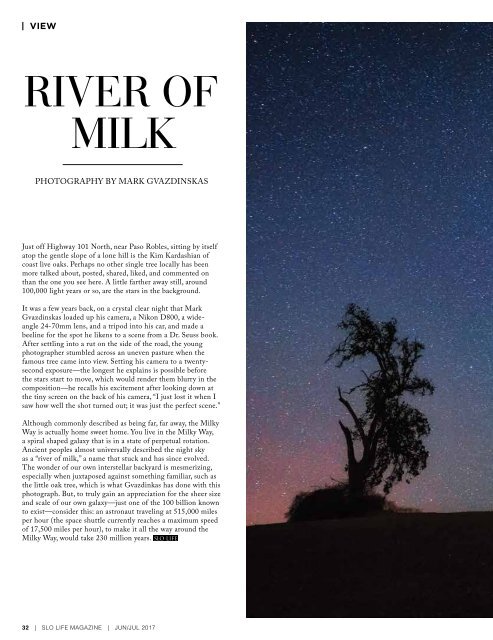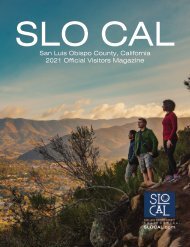SLO LIFE Jun/Jul 2017
Create successful ePaper yourself
Turn your PDF publications into a flip-book with our unique Google optimized e-Paper software.
| VIEW<br />
RIVER OF<br />
MILK<br />
PHOTOGRAPHY BY MARK GVAZDINSKAS<br />
Just off Highway 101 North, near Paso Robles, sitting by itself<br />
atop the gentle slope of a lone hill is the Kim Kardashian of<br />
coast live oaks. Perhaps no other single tree locally has been<br />
more talked about, posted, shared, liked, and commented on<br />
than the one you see here. A little farther away still, around<br />
100,000 light years or so, are the stars in the background.<br />
It was a few years back, on a crystal clear night that Mark<br />
Gvazdinskas loaded up his camera, a Nikon D800, a wideangle<br />
24-70mm lens, and a tripod into his car, and made a<br />
beeline for the spot he likens to a scene from a Dr. Seuss book.<br />
After settling into a rut on the side of the road, the young<br />
photographer stumbled across an uneven pasture when the<br />
famous tree came into view. Setting his camera to a twentysecond<br />
exposure—the longest he explains is possible before<br />
the stars start to move, which would render them blurry in the<br />
composition—he recalls his excitement after looking down at<br />
the tiny screen on the back of his camera, “I just lost it when I<br />
saw how well the shot turned out; it was just the perfect scene.”<br />
Although commonly described as being far, far away, the Milky<br />
Way is actually home sweet home. You live in the Milky Way,<br />
a spiral shaped galaxy that is in a state of perpetual rotation.<br />
Ancient peoples almost universally described the night sky<br />
as a “river of milk,” a name that stuck and has since evolved.<br />
The wonder of our own interstellar backyard is mesmerizing,<br />
especially when juxtaposed against something familiar, such as<br />
the little oak tree, which is what Gvazdinkas has done with this<br />
photograph. But, to truly gain an appreciation for the sheer size<br />
and scale of our own galaxy—just one of the 100 billion known<br />
to exist—consider this: an astronaut traveling at 515,000 miles<br />
per hour (the space shuttle currently reaches a maximum speed<br />
of 17,500 miles per hour), to make it all the way around the<br />
Milky Way, would take 230 million years. <strong>SLO</strong> <strong>LIFE</strong><br />
32 | <strong>SLO</strong> <strong>LIFE</strong> MAGAZINE | JUN/JUL <strong>2017</strong>


















